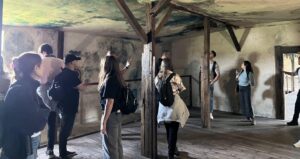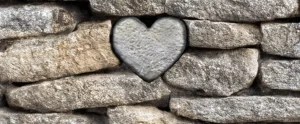The cross has become a much-loved symbol across the world, representing the ultimate self-sacrifice and moment that sin was paid for. It reminds believers of heaven and earth meeting, grace and righteous justice kissing, and the event that all previous sacrifices had been pointing towards for centuries. However, for others, the cross carries a lot of baggage, and negative connotations. People might think they know a fair amount about the symbol and what it represents, but here are a few things that might be new to you.
1. When camping in the desert, the Israelites pitched their tents in the formation of a cross.
In the Numbers 2, God gives clear instructions about where each tribe should pitch their tents in the four directions of the compass: three tribes to the north, three to the south, three to the east, and three to the west. But what is interesting is that the number of people in each tribe was not equal. What we find in total are:
64,600 + 54,400 + 57,400 (Judah, Issachar and Zebulun, to the East) = 186,400
46,500 + 59,300 + 45,650 (Reuben, Simeon and Gad, to the South) = 151,450
40,500 + 32,200 + 35,400 (Ephraim, Manasseh and Benjamin, to the West) = 108,100
62,700 + 41,500 + 53,400 (Dan, Asher and Naphtali, to the North) = 157,600
If you represent these numbers in centimeters, and try to draw it, you’ll form a cross (18.6cm, 10.8cm, 15.1cm and 15.7cm). The “bottom” of the cross are the more numerous tribes of Judah, Issachar and Zebulun, stretching out to the East, and the top are Rachel’s offspring, camped tents that reach over to the West, with two arms of camps of similar number branching out North and South. Is this a coincidence? I don’t think God does coincidences. He gave the increase to the tribes as he saw fit, and he arranged them around his tabernacle like that on purpose. Israel was moving around the desert, following their God in the cloud, and making the formation of a cross wherever they set up camp.
2. In Israeli schools, writing the “plus” sign is frowned upon, because it looks too much like a cross
The addition symbol we use here in Israel looks like this: ﬩ , like an upside down ‘T’. A regular plus sign (+) looks way too much like a cross, and is carefully avoided in the Israeli school system as a result.
For the Jewish people, the sign of the cross can provoke a reaction not dissimilar to a swastika. Often Christians do not know what Jewish people have suffered in the name of the cross, and so fail to understand the strong, negative reaction to it. But here’s roughly what happened: After being expelled from Israel shortly after the time of Jesus, many Jewish people over time migrated West and many settled in European countries. Christians countries. Perhaps there they could hear the gospel in a way that made sense to them? Experience Christian love, and have a revelation of the Messiah? Sadly, the opposite happened. For many centuries, Jewish people were not only viciously discriminated against, but were tortured and killed by people brandishing crosses. By Christians. Country after country would forcibly expel their Jewish populations unless they converted to Christianity. But that seemed like idol worship to Jewish people, who had strongly received the message that God is one, not three. Bowing down to statues and crosses seemed to them to go against the very first commandment. The clash was harsh and the reprisals merciless.
A Jewish writer from the Middle Ages called Joseph Zarpharthi fled with his family from Germany to Turkey, and described the “Happy lot of the Jews under the Crescent as compared with their hard fate under the shadow of the Cross”1. Historian Shlomo Schechter wrote that the lands of Christendom were places where “love was preached and murder acted”2. During the Crusades, some Jewish (and Muslim) people had crosses cruelly carved into their backs with swords, and needless to say, the Nazis considered themselves to be Christian and used the symbol of the cross, even though they were acting in the exact opposite spirit of it.
I hope you can begin to see why Jewish people might have gradually developed a strong aversion to the symbol of what they perceived to be the source of all the hatred that they were subjected to.
For this reason, Israeli congregations who are trying to encourage Jewish non-believers to feel welcome in an environment where they can meet their Messiah and hear the good news, will often avoid placing a cross in any prominent position. You might see the symbol of a menorah to represent Yeshua instead, but on the whole, paraphernalia is kept at a minimum. It is a conscious decision to create an environment where a Jewish person can feel welcome and free to be in that place of blessing without unnecessarily provoking strong, negative reactions before they can even hear the message. Hebrew gospel tracts used in Israel might have an illustration of a lamb on the altar at the point at which atonement for sin is explained, rather than a picture of a cross. The message of the cross is preached, but the symbol with all its connotations is usually avoided.
3. There is a protein that holds all our cells together, that is in the shape of a cross
Luis Giglio gave a sermon a while back (you can find it on YouTube) that made this particular protein called laminin famous. He showed how laminin has one long string with two other strings either side which twist around the base, forming a cross. What is so amazing about this particular cross-shaped protein is that it is considered to be the “glue” which holds all tissue together – our skin, intestines, our muscles, would all fall apart without this ‘glue’ protein. Perhaps you might think it a coincidence, but then again, perhaps God deliberately designed it this way as a sign and a clue that he knew we would discover, to highlight the importance of the cross! Giglio connected it with this passage in Colossians, which talks about how all things are held together by our Messiah:
He is the image of the invisible God, the firstborn of all creation.
For by Him all things were created—
in heaven and on earth, the seen and the unseen,
whether thrones or angelic powers
or rulers or authorities.
All was created through Him and for Him.
He exists before everything,
and in Him all holds together.
He is the head of the body, His community.
He is the beginning, the firstborn from the dead—
so that He might come to have first place in all things.
For God was pleased to have all His fullness dwell in Him
and through Him to reconcile all things to Himself,
making peace through the blood of His cross—
whether things on earth or things in heaven!
(Col 1:15-20)
This cross is no optional extra – it is the only hope of salvation and life that we have! Satan may have snatched this powerful symbol from the Jewish people for now, and twisted it into something that invokes horror, but we know from God’s word that one day, the whole House of Israel will see the cross with new eyes, and understand what it means for them too:
“Then I will pour out on the house of David and the inhabitants of Jerusalem a spirit of grace and supplication, when they will look toward Me whom they pierced. They will mourn for him as one mourns for an only son and grieve bitterly for him, as one grieves for a firstborn. In that day there will be a great mourning in Jerusalem, mourning like Hadad-rimmon in the valley of Megiddo. The land will mourn clan by clan.” (Zechariah 12:10-12)
Just as the tribes camped out in a cross shape thousands of years before the crucifixion took place, so the tribes of Israel will have that revelation of what it means – clan by clan – and come into the repentance that leads to salvation. The old will be washed away – Jewish unbelief and the brutality of the gentile church throughout the ages – and all things will be made new. The two directions of the cross beams, vertical and horizontal, remind us that just as heaven and earth met and were reconnected because of the Messiah’s sacrifice, so the horizontal crossbar speaks of the restoration that the cross brings in our relationships with one another too.
God will reconcile all things to Himself, making peace through the blood of His cross—both on earth and in heaven.
1. “The Geonim of the Babylonia and the Shaping of Medieval Jewish Culture, ” Robert Brody, Yale University Press, 1998, introduction
2. “Safed in the Sixteenth Century: A City of Legists and Mystics.” In Studies in Judaism, second series, 202-328. Philadelphia: e Jewish Publication Society of America, 1908. p270
















